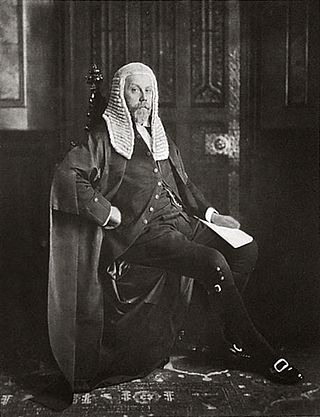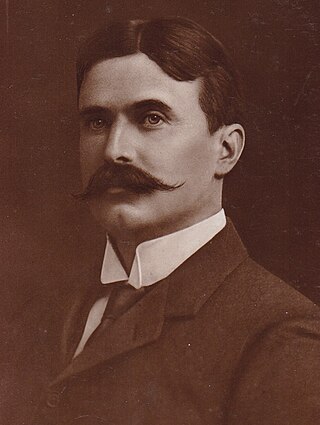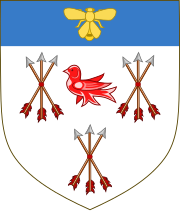
Marquess of Aberdeen and Temair, in the County of Aberdeen, in the County of Meath and in the County of Argyll, is a title in the Peerage of the United Kingdom. It was created on 4 January 1916 for John Hamilton-Gordon, 7th Earl of Aberdeen.

Earl of Chesterfield, in the County of Derby, was a title in the Peerage of England. It was created in 1628 for Philip Stanhope, 1st Baron Stanhope. He had been created Baron Stanhope, of Shelford in the County of Nottingham, in 1616, also in the Peerage of England. Stanhope's youngest son, the Hon. Alexander Stanhope, was the father of James Stanhope, 1st Earl Stanhope, while his half-brother Sir John Stanhope of Elvaston was the great-grandfather of William Stanhope, 1st Earl of Harrington.

Arthur Wellesley Peel, 1st Viscount Peel,, was a British Liberal politician, who sat in the House of Commons from 1865 to 1895. He was Speaker of the House of Commons from 1884 until 1895, when he was raised to the peerage.

Earl of Jersey, is a title in the Peerage of England. It is held by a branch of the Villiers family, which since 1819 has been the Child Villiers family.

Earl of Wilton, of Wilton Castle in the County of Herefordshire, is a title in the Peerage of the United Kingdom. It was created in 1801 for Thomas Egerton, 1st Baron Grey de Wilton, along with the subsidiary title of Viscount Grey de Wilton, also in the Peerage of the United Kingdom. Both titles were created with remainder to the second and all younger sons successively of his daughter Eleanor, wife of Robert Grosvenor, 1st Marquess of Westminster.

Earl of Lonsdale is a title that has been created twice in British history, firstly in the Peerage of Great Britain in 1784, and then in the Peerage of the United Kingdom in 1807, both times for members of the Lowther family.

Earl of Clanwilliam is a title in the Peerage of Ireland. It was created in 1776 for John Meade, 1st Viscount Clanwilliam. The Meade family descends from Sir John Meade, who represented Dublin University and County Tipperary in the Irish House of Commons and served as Attorney-General to James, Duke of York. In 1703, he was created a Baronet, of Ballintubber in the County of Cork, in the Baronetage of Ireland. His eldest son, Pierce, the second Baronet, died unmarried at an early age and was succeeded by his younger brother Richard, the third Baronet. Richard represented Kinsale in the Irish Parliament.

Earl of Mornington is a title in the Peerage of Ireland. It was created in 1760 for the Anglo-Irish politician and composer Garret Wellesley, 2nd Baron Mornington. On the death of the fifth earl in 1863, it passed to the Duke of Wellington; since that date, the title has generally been used by courtesy for the heir apparent to the heir apparent to the dukedom.

Earl of Minto, in the County of Roxburgh, is a title in the Peerage of the United Kingdom. It was created in 1813 for Gilbert Elliot-Murray-Kynynmound, 1st Baron Minto. The current earl is Gilbert Timothy George Lariston Elliot-Murray-Kynynmound, 7th Earl of Minto.
Earl of Bradford is a title that has been created twice, once in the Peerage of England and once in the Peerage of the United Kingdom. It was first created in 1694 for Francis Newport, 2nd Baron Newport. However, all the Newport titles became extinct on the death of the fourth Earl in 1762. The earldom was revived in 1815 for Orlando Bridgeman, 2nd Baron Bradford. The Bridgeman family had previously succeeded to the Newport estates. The title of the peerage refers to the ancient hundred of Bradford in Shropshire, and not, as might be assumed, to the city of Bradford, Yorkshire, or the town of Bradford-on-Avon in Wiltshire.

Earl Cowley is a title in the Peerage of the United Kingdom. It was created in 1857 for the diplomat Henry Wellesley, 2nd Baron Cowley. He was Ambassador to France from 1852 to 1867. He was made Viscount Dangan, of Dangan in the County of Meath, at the same time as he was given the earldom. This title is also in the Peerage of the United Kingdom. Lord Cowley was the eldest son of Henry Wellesley, 1st Baron Cowley, who like his son served as Ambassador to France. In 1828 he was created Baron Cowley, of Wellesley in the County of Somerset, in the Peerage of the United Kingdom. A member of the prominent Wellesley family, Cowley was the fifth and youngest son of Garret Wellesley, 1st Earl of Mornington, and the younger brother of Arthur Wellesley, 1st Duke of Wellington, and Richard Wellesley, 1st Marquess Wellesley.

Earl St Aldwyn, of Coln St Aldwyn in the County of Gloucester, is a title in the Peerage of the United Kingdom. It was created in 1915 for the prominent Conservative politician Michael Hicks Beach, 1st Viscount St Aldwyn, known from 1854 to 1907 as Sir Michael Hicks Beach, 9th Baronet, of Beverston. He was Chancellor of the Exchequer from 1885 to 1886 and again from 1895 to 1902. Hicks Beach had already been created Viscount St Aldwyn, of Coln St Aldwyn in the County of Gloucester, in 1906, and was made Viscount Quenington, of Quenington in the County of Gloucester, at the same time he was given the earldom. Both titles are in the Peerage of the United Kingdom. He was succeeded by his grandson, the second Earl, the son of Michael Hicks Beach, Viscount Quenington, Member of Parliament for Tewkesbury, who was killed in action in 1916. Lord St Aldwyn was also a Conservative politician and was Captain of the Honourable Corps of Gentlemen-at-Arms between 1958 and 1964 and 1970 and 1974. As of 2018 the titles are held by his eldest son, the third Earl, who succeeded in 1992.

Viscount Ullswater, of Campsea Ashe in the County of Suffolk, is a title in the Peerage of the United Kingdom. It was created in 1921 for James Lowther upon his retirement as Speaker of the House of Commons. He was the eldest son of the Hon. William Lowther, third son of the Hon. Henry Lowther, second son of William Lowther, 1st Earl of Lonsdale. The first Viscount lived to the age of 93, and was pre-deceased by both his eldest son the Hon. Christopher Lowther, a Conservative politician, and his eldest son's eldest son John Arthur Lowther (1910–1942), the title being inherited by his seven-year-old great-grandson, the second and current Viscount, in an extremely rare instance of a great-grandson succeeding his great-grandfather in a peerage. The second Viscount held office in the Conservative administrations of Margaret Thatcher and John Major and since 2003 he has been one of the ninety elected hereditary peers that remain in the House of Lords after the passing of the House of Lords Act 1999.

William Robert Wellesley Peel, 1st Earl Peel,, 2nd Viscount Peel from 1912 to 1929, was a British politician who was a local councillor, a Member of Parliament and a member of the House of Lords. After an early career as a barrister and a journalist, he entered first local and then national politics. He rose to hold a number of ministerial positions but is probably best remembered for chairing the Peel Commission in 1936–1937, which recommended for the first time the partition of the British Mandate of Palestine into separate Jewish and Arab states.
Francis Robert Stonor, 4th Baron Camoys was a British aristocrat who served as Lord-in-Waiting to Queen Victoria.

Robert Wellesley Grosvenor, 2nd Baron Ebury was a British politician.
Arthur William Ashton Peel, 2nd Earl Peel, styled Viscount Clanfield from 1929 to 1937, was a British peer.

The Lyttelton family is a British aristocratic family. Over time, several members of the Lyttelton family were made knights, baronets and peers. Hereditary titles held by the Lyttelton family include the viscountcies of Cobham and Chandos, as well as the Lyttelton barony and Lyttelton baronetcy. Several other members of the family have also risen to prominence, particularly in the field of cricket.
Hercules Langford Rowley PC was an Irish politician and landowner.
Lieutenant Colonel William Henry Wellesley, 2nd Earl Cowley was an English aristocrat and soldier.














